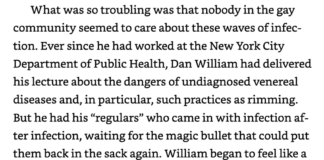
Forty years ago, CDC first reported on Pneumocystis pneumonia in five previously healthy young gay men in Los Angeles. Published on June 5, 1981, in the Morbidity and Mortality Weekly Report (MMWR), this was the first CDC report of what would be known as HIV. The first U.S. cases in women were reported later that same year. Over the next five years, 29,000 cases of HIV/AIDS were reported in the U.S. With no effective treatment available for 15 years, death was the only certain outcome.
This public health crisis triggered unprecedented activism that drove support for the thousands of people dying from the virus each year.
By 1995, when I was a newly trained physician, hospitals across the country were filled with young men and women dying of AIDS.
In my first years, all I had to give my patients was my outstretched hand and my presence at their bedside. The epidemic raged in the halls of the hospitals and the streets of Baltimore where I worked. Fifty-thousand people were dying each year. And then we reached a turning point. In December 1995 and in 1996, FDA authorized the first combinations of highly effective treatment. My message at the bedside changed: you can live.
Today, looking back, I know that we have come so far. A CDC study published today in the MMWR reports that new annual HIV infections decreased 73% from 1981 to 2019. Reductions are due to the decades-long work of and collaboration with scientists, patients, patient-advocates and communities. Targeted programmatic efforts at the federal, state, territorial, tribal, and local levels have translated tremendous advancements in science and medicine into safe and effective interventions delivered to the people at risk.
Despite our extraordinary progress, the HIV epidemic in this country continues, and we still have much work to do. It is unacceptable that 37,000 people are newly diagnosed with HIV each year in the United States. Disparities in diagnoses and access to treatment and prevention persist. Over half of new HIV infections are in the South, and new infections remain high among transgender women, people who inject drugs, and Black/African American and Hispanic/Latino gay and bisexual men.
Erasing HIV disparities requires us to leverage and build on the hard work of so many activists and public health leaders over the past four decades. We must recognize and address the barriers that prevent effective implementation of our proven prevention strategies, like poverty, unequal access to health care, lack of access to education, stigma, and systematic racism.
The Ending the HIV Epidemic in the United States initiative sets a course to end our country’s HIV epidemic over the next decade. The scientific and clinical tools are available: testing, treatment, and prevention. We must fully fund and urgently and equitably implement what we know works, such as PrEP distribution and education, syringe service programs, and an infrastructure for rapid response to potential HIV outbreaks.
In doing so, we will honor all of those touched by this virus – from those five cases initially reported on June 5, 1981, to the 32 million people who have died from AIDS-related illness globally, including 730,000 people in this country, and so many more living with and fighting against the virus and its associated stigma every single day.







